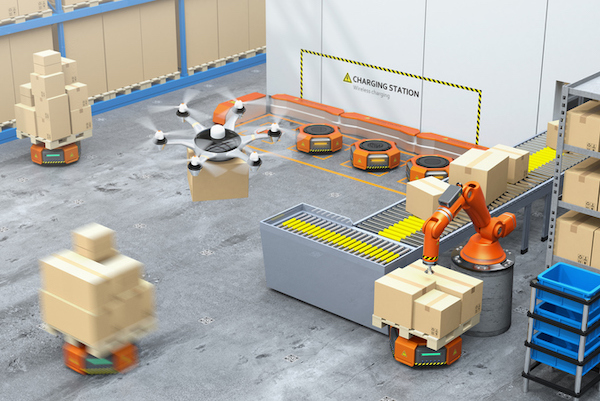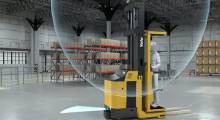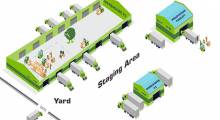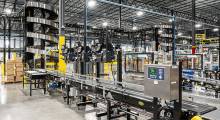Retail e-commerce is reshaping the world with double-digit growth annually. The byproduct of this boom is the rapid growth of the warehouse industry, with massive facilities popping up across the country. But, with the historically low unemployment in the U.S., staffing positions are difficult to fill. In this article, we explore how the warehouse industry is starting to use autonomous robots and drones with advanced sensing capabilities to improve operations.
According to analytics and measurement company Comscore, online retail spending in the U.S. surpassed $1 trillion last year – on everything from groceries to consumer electronics, where strict inventory management is paramount. Today, online shoppers can order goods 24/7, with an increasing number of retailers offering next-day delivery. This quick turnaround puts massive pressure on warehouse operations in terms of goods in and goods out, material handling, and pick and pack operations.
Enter, the autonomous mobile robot—or AMR, such as this example—and, more recently, autonomous drones – with intelligent sensor technologies being the key enabler to both.
Steady adoption of smarter warehouse automation
Against this backdrop, automated guided vehicles—AGVs, such as these from VisionNav—have been a mainstay in moving items around the warehouse. Essentially, they are robotic carts that transport goods from one place to another.
AGVs follow predetermined routes, following magnetic tape, wires, or markers on the floor, similar to railway tracks. But unlike trains, they can adapt to their environment. They use sensors, such as cameras, laser imaging, detection, and ranging (lidar), and ultrasonic time-of-flight (ToF) sensors, to detect objects and avoid collisions.
However, because AGVs can only change their route or destination with manual intervention, they are generally limited to a particular task. Lack of flexibility and limited decision-making capabilities have led to more advanced robots.
AMRs take the AGV concept a step further with the ability to navigate more complex environments. Unlike AGVs, AMRs are able to adapt to changes in their surroundings, flexibly navigating through the warehouse without colliding with other objects or causing damage. This is where simultaneous localization and mapping (SLAM) technology comes in.
SLAM enables safe navigation
But what exactly is SLAM, and how does it work? It is a bit like how we use our eyes and ears to navigate a crowded room. We can sense where objects are in relation to us, and we use that information to move around without bumping into anyone.
In the same way, SLAM uses a combination of sensors, cameras, and mapping technology to create a real-time map of the environment, allowing autonomous robots to navigate around obstacles and avoid collisions more effectively.
A key element of SLAM technology is the inertial measurement unit (IMU), which measures the AMR’s acceleration, orientation, and angular velocity. The IMU allows it to track its position and movement accurately. Often referred to as dead reckoning, it's like having a built-in compass, GPS, and speedometer all in one—a sort of sixth sense for the robot—even in areas where GPS signals may be weak or nonexistent.
But that's not all. AMRs can also communicate with the warehouse management system (WMS) so they can be routed to specific locations based on inventory needs or custom orders. This means they can be used for various tasks, from picking and packing orders to transporting goods around the warehouse.
Overall, AMRs are like the ultimate chauffeur, able to expertly navigate a complex environment and adapt to changing circumstances on the fly.
Autonomous robot swarms can share the load
As AMR technology advances further, we expect even more exciting developments in this field, with autonomous robots becoming more intelligent and versatile than ever before. One such development is swarm autonomy. Picture a swarm of bees flying together in perfect formation, each bee adjusting its flight pattern in real-time to maintain the optimal position.
In a warehouse setting, swarm autonomy requires a wireless communications network with real-time capability. Using a combination of sensors and artificial intelligence or machine learning algorithms, the AMRs can communicate with one another using the network instead of following the commands of the centralized system.
By coordinating among themselves, the robots can quickly decide which can collect a particular package from Point A and deliver it to Point B most efficiently. For example, they can also support one another. If a package is too heavy for one AMR, two AMRs can share the burden.
This approach offers several advantages. For example, it allows AMRs to accomplish tasks more quickly and efficiently together than they could on their own. It also provides redundancy. If one AMR fails, another can take on the task.
Warehouse drones take flight
When we think of drones, we might picture them flying high in the sky, capturing stunning aerial footage. But did you know that drones are also becoming an increasingly common sight in warehouses around the world?
The use of drones in warehouses is a growing trend. Drones offer a unique set of advantages that make them well-suited for warehouse tasks, with numerous kinds of sensors in drones. For example, they can survey inventory levels, track assets, and perform routine maintenance inspections.
One of the key advantages of using drones in warehouses is their ability to cover large areas quickly and accurately. A drone can fly over an entire warehouse and capture high-resolution images of every inch of the space in a fraction of the time it would take a human worker to do the same thing. This allows for more efficient inventory management and better overall warehouse organization.
Drones offer more uses
But drones can perform more than surveying and inspection tasks. Using autonomous drones in warehouses is like having a highly skilled aerial assistant. Drones can be used for picking and packing orders, transporting items from one location to another, monitoring warehouse security, and even performing cleaning and maintenance activities.
Some companies are experimenting with using drones equipped with mapping software to create 3D maps of a warehouse to help optimize its layout, detect out-of-place objects, and improve efficiency. Drones can also collect data such as temperature, humidity, and light levels in a warehouse to maintain ideal conditions for stored products.
As with AMRs, drones use IMUs for dead reckoning to improve navigation accuracy during flight and swarm autonomy for collaborative working. In addition, envision swarm drones communicating directly with swarm AMRs.
For instance, if a package is high on a shelf, the drone could select itself to pick the package in preference to allocating the task to an AMR. Or in the instance of a layout change within the warehouse, the up-to-the-minute 3D mapping from the swarm drones can be fed dynamically into the navigation system of the swarm AMRs, keeping everything moving efficiently.
Altitude hold a challenge for drones
In more sophisticated drones, the IMUs are supplemented with other sensors. An integrated pressure sensor can improve the accuracy of altitude hold. While one might assume that air pressure remains constant in a facility, switching on or off the HVAC (heating, ventilation, and air conditioning) system or opening and closing doors can change it, misleading the drone.
To illustrate how even a slight change in air pressure can affect the drone’s altitude hold, let us work some numbers. An IMU that integrates a pressure sensor with a ±1 Pa accuracy is equivalent to a height change of 3.5 in. (8.5 cm) at sea level.
A door opening or closing, for example, can cause a pressure change of 10 Pa or more causing a change of height of nearly 3 ft. (85 cm). Whether there is a decrease or increase in air pressure, it could result in the drone hitting the ceiling or floor.
The solution to this problem is to use a second pressure sensor to compare the two readings. In our swarm warehouse example, the grounded AMR can supply its pressure sensor reading to the network as the ambient air pressure since it won't change height.
The difference between the pressure reading from the IMU’s pressure sensor and the ambient pressure gives a more accurate, compensated pressure reading. Also, additional ultrasound ToF sensors mounted on the the drone add further robustness. The bottom-mounted ToF sensors are also helpful for gentle landings, notably when landing on a recharging nest.
Benefits of sequential charging regimes
The workdays of autonomous robots and drones are limited primarily by their battery life. Regardless of how they are set up to save energy, they still need charging.
A conventional charging schedule would combine the remaining charge level and fixed periods to decide when to recharge the battery. Similar to a worker taking a lunch break, they need to recharge regularly.
This charging schedule worked well in the past, but with the rise of AMRs and drones and the increasing size of routes they need to travel, control management has become extremely complicated. If a battery goes flat and the robot is not near a charging station, a manual battery replacement is needed; this unplanned maintenance costs time and money.
Battery swapping also increases the possibility of human error during the battery changeover. And, consider that any time robots are out of action, they are not working, reducing productivity and putting more workload on the other systems in the facility. For AMRs and autonomous drones, sequential recharging is highly beneficial for improving operational efficiency.

About the author
Peter Hartwell is chief technology officer and vice president of sensor solutions at InvenSense, a TDK Group Company. He has over 25 years’ experience commercializing silicon MEMS products, working on advanced sensors and actuators, and specializes in MEMS testing techniques.
At InvenSense, Hartwell is responsible for technology strategy and leads its Advanced Technology research group. Prior to joining InvenSense, Hartwell spent four years as architect of sensing hardware at Apple, and before that, he was a distinguished technologist at Hewlett-Packard Laboratories for 12 years.
Article topics
Email Sign Up


















